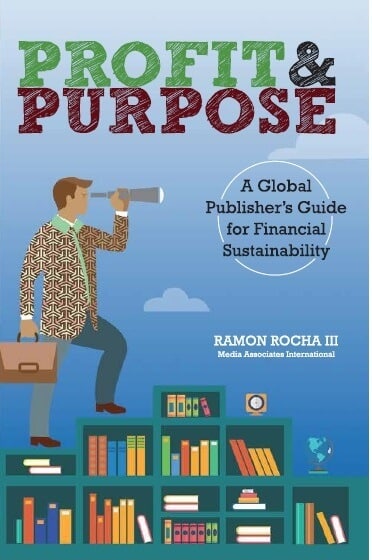That fumbling publisher was me!
Will Christian publishing in the Majority World always require subsidies in order to survive? Or can publishers flourish on income generated from their publishing operations alone? This daunting goal may be difficult to achieve, but is possible, according to author Ramon Rocha III, MAI director of publisher development. In our new book, Profit and Purpose: The global publisher’s guide for financial sustainability, he offers wisdom from decades of experience in business, Christian publishing and global consulting. This title provides key principles and practical strategies to equip global Christian publishers to pursue financial sustainability.
Not a publisher? You’ll still enjoy Ramon’s insights and this excerpt:
Could the market absorb 10,000 copies of a full-color, hardcover and pricey children’s Bible storybook? One exuberant publisher failed to research the answer before ordering 5,000 English copies and 5,000 copies in the native language from a printer abroad. He was convinced he could sell that many copies to as many families in one year, impacting lives and earning profit, too!
One exuberant publisher failed to research the answer before ordering 5,000 English copies and 5,000 copies in the native language from a printer abroad. He was convinced he could sell that many copies to as many families in one year, impacting lives and earning profit, too!
After an initial burst of sales in the first six months, sales began to taper off. The inevitable cash flow pressure reared its ugly head. Dust started to accumulate on book cartons in the warehouse. What went wrong? Why, oh why?
Full disclosure: that fumbling publisher was me! Maybe the illustrations in the book were too old-fashioned to appeal to modern kids? Maybe we should have chosen a shorter book with more contemporary drawings? A softcover would have been cheaper and more affordable, right? Maybe we were not really thinking about the reader? But who was the reader in the first place—the child, mother, father, grandfather or grandmother?
Maybe we did not market sufficiently? Maybe we should have placed targeted ads in magazines and newspapers or created more fliers? Maybe book tables in more churches would have helped? Maybe 10,000 copies was simply a case of an overly enthusiastic publisher? Maybe all of the above?
Are you practicing “come-what-may” marketing, the strategy of “we produce books, then we try to do whatever we can to sell and market them?” Perhaps it’s time to become more intentional and thoughtful, not only in selecting titles but also in crafting your marketing plans.
I have observed the components of marketing evolve over the years. Marketing gurus like Philip Kotler previously focused on the four Ps: product, price, promotion and place. Those remain essential today, but technology and the ease of marketing directly online has changed the game. Marketing has taken on a much more personal slant for the customer: “What’s in it for me?”
In hindsight, I was thinking more about me than the readers of that children’s Bible storybook. You, the publisher, should stay focused on readers while aiming to be financially sustainable. In short, stay reader-centric. Your marketing efforts should be focused on reaching your reader.
Are you in a country whose population is not predominantly Christian? If so, effective marketing is sensitive, friendly and inoffensive to people of other faiths. Remember, the general market is bigger than the Christian market. If that is your situation, you have greater chances of enlarging your market share and potentially reaching more people with the Gospel.
General readers are not predisposed to buy your products, so find creative means to engage them. First, offer reading materials that provide hope to hurting hearts and lives. These products need not be explicitly Christian. They could be bridge-building or crossover materials—books for children, young people, teenagers, young professionals, business people, parents and seniors. Words from our loving Heavenly Father contextualized by local authors will provide guidance, comfort and encouragement to these readers. Ensure you have quality books to market to your target general readers.
From my past experience as a publisher, and current consulting with publishing leaders for MAI, I believe a Christian publisher can follow these six action points to achieve financial viability:
- Create thoughtful strategic plans.
- Build a steady backlist of bestsellers. Consistently publish quality books that readers need and want, sold at the right prices, when and where they want them.
- Connect with target readers through innovative, ”reader-centric” marketing strategies.
- Properly steward cash, inventory and other resources.
- Regularly measure financial health and make necessary adjustments.
- Continuously build a highly skilled and motivated staff, united in pursuing the organization’s purposes and goals.

We will tackle each point in six separate chapters. I have limited discussion to factors within the control of the publisher, understanding that some publishers experience problems like political instability, economic hardship, low literacy rates and other realities.
Jeff Johnson, president of Tyndale House Publishers in the USA, provided perspective when he said, “Big and small publishers are both confronted with the same issues to be financially sustainable. It is just a matter of scale.” Christian publishers in the USA, UK, Indonesia and Zimbabwe go through the same financial challenges. Some may be dealing with bigger revenues, costs and markets than others, but each must contend with the challenge of how to become successful for the long term.
Is your publishing financially sustainable?
Purchase your print copy for $9.99 USD from MAI. Print book orders from PGDirect may result in lower costs in certain countries. Also available as an ebook in Kindle, Nook, Kobo.

